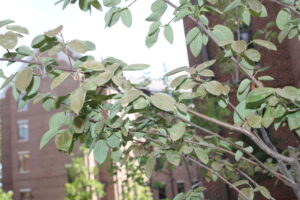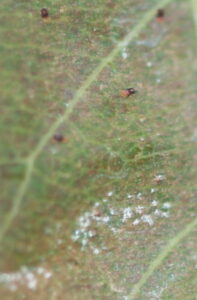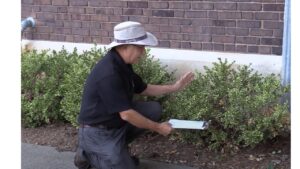Mites are eight-legged arthropods who pierce plant cells to feed on them. Plants that are attacked by mites lose their green color and appear somewhat bronzed. Spider mites will make webs to help them forage on leaves unencumbered by irregular leaf surfaces. The accumulation of webs, and old skins of mites can give heavily infested plants a dusty appearance. This can make plants unsightly and affect their health.
Lack of rain this summer and fall has spared spider mites from drowning and being washed off leaves during heavy rains. Warm weather in late August and September allowed warm season mites, like two spotted spider mite, European red mite on flowering fruit trees, honeylocust, maple and oak spider mites to flourish. With the daily highs consistently below 85 F, cool season mites like spruce spider mite, boxwood spider mite and southern read mite have been increasing in number.
Now would be a good time to take stock of which plants have spider mites to help you plan your control strategy.
- Figure 1. Plants infested with mites appear to be bronzed from tiny stipples.
- Figure 2. This serviceberry leaf has live European red mites, eggs and old shed skins that accumulate on the leaf.
- Figure 3. Tap the branches over a white sheet of paper. After giving the mites 10 seconds to grab hold of the paper, turn the sheet sideways to let the debris fall off. Then examine the specs to determine if they are spider mites. A 10X hand lens or smartphone can help you see these small pests.
Cool season mites, including southern red mite, boxwood spider mite and spruce spider mite may require treatment this fall to keep their populations from building. This could be accomplished with a garden hose and a strong stream of water or a 2% solution of horticultural oil or insecticidal soap.
At this point in the season, there is usually no need to spray trees for warm season spider mites. Because most spider mites will winter on trees and shrubs, these mite infested trees can be targeted for a spray of oil during the dormant season. It is important to note that plants with two spotted spider mites will not benefit from an oil spray because they winter in the ground cover. Also, be sure not to spray oil on shrubs with waxy blue leaves. This wax often protects plant leaves from strong winds and sun in the winter.
More Management tips
Be sure to watch our new 5 minute video for quick tips on how to recognize, scout for ant treat spider mites in English or in Spanish. For more details on managing spider mites please visit PurduePlantDoctor.Com.
For more information on specifics see our bulletin on managing spider mites in the urban landscape.


